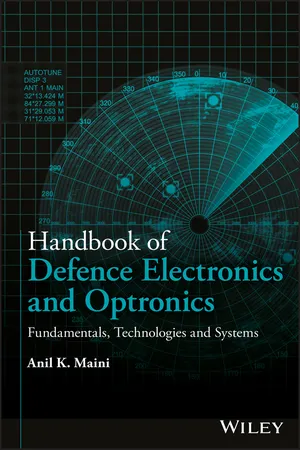
Handbook of Defence Electronics and Optronics
Fundamentals, Technologies and Systems
Anil K. Maini
- English
- ePUB (disponibile sull'app)
- Disponibile su iOS e Android
Handbook of Defence Electronics and Optronics
Fundamentals, Technologies and Systems
Anil K. Maini
Informazioni sul libro
Handbook of Defence Electronics and Optronics
Anil K. Maini, Former Director, Laser Science and Technology Centre, India
First complete reference on defence electronics and optronics
Fundamentals, Technologies and Systems
This book provides a complete account of defence electronics and optronics. The content is broadly divided into three categories: topics specific to defence electronics; topics relevant to defence optronics; and topics that have both electronics and optronics counterparts.
The book covers each of the topics in their entirety from fundamentals to advanced concepts, military systems in use and related technologies, thereby leading the reader logically from the operational basics of military systems to involved technologies and battlefield deployment and applications.
Key features:
• Covers fundamentals, operational aspects, involved technologies and application potential of a large cross-section of military systems.
- Discusses emerging technology trends and development and deployment status of next generation military systems wherever applicable in each category of military systems.
• Amply illustrated with approximately 1000 diagrams and photographs and around 30 tables.
• Includes salient features, technologies and deployment aspects of hundreds of military systems, including: military radios; ground and surveillance radars; laser range finder and target designators; night visions devices; EW and EO jammers; laser guided munitions; and military communications equipment and satellites.
Handbook of Defence Electronics and Optronics is an essential guide for graduate students, R&D scientists, engineers engaged in manufacturing defence equipment and professionals handling the operation and maintenance of these systems in the Armed Forces.
Domande frequenti
Informazioni
1
Military Communications
1.1 Introduction to Military Communications
